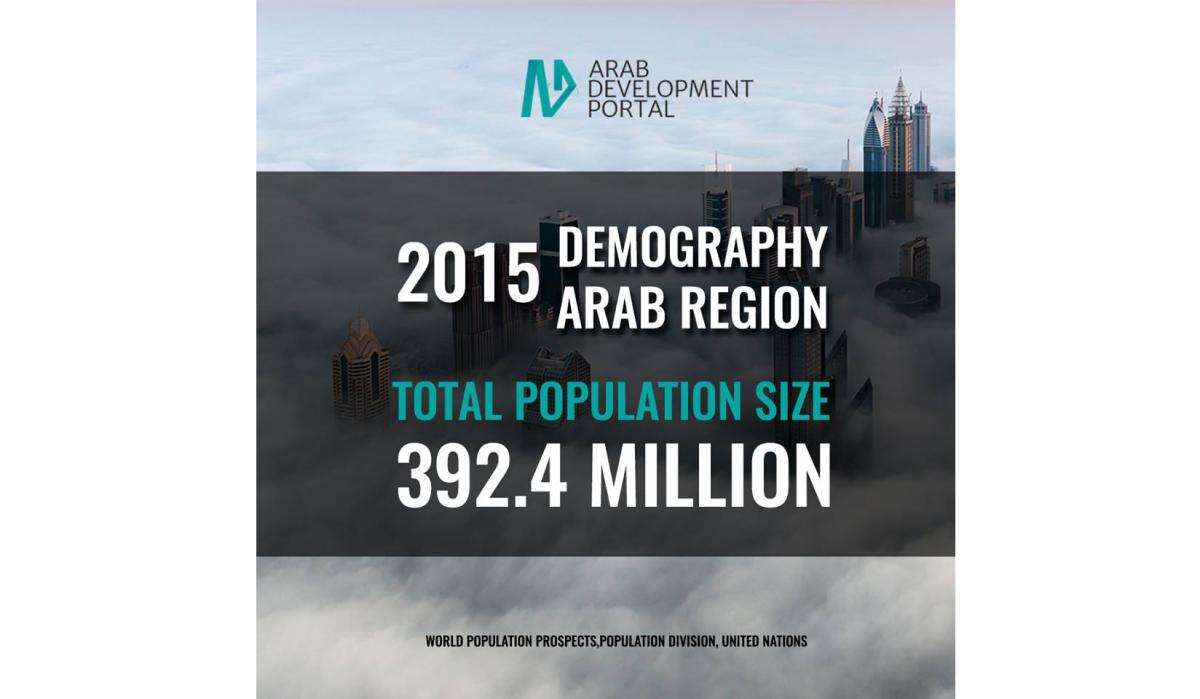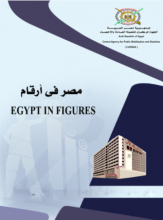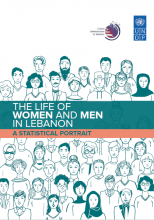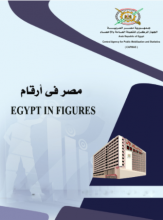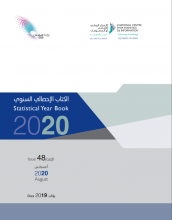Demography
The population in the Arab countries has been increasing over the past decades. The Arab region is home to an estimated 444.81 million inhabitants in 2021, growing from 216.9 million in 1990. Today, the Arab population represents 5.6 percent of the world population with 80 percent of the region’s population being concentrated in eight countries: Egypt, Algeria, Sudan, Iraq, Morocco, Saudi Arabia, Yemen, and Syria. The population in the Arab Region is relatively young, with adolescents and youth aged 10 to 24 years representing more than a quarter of the total population.[1]
The increase in population in the past three decades is mainly due to the rapid decline in the mortality rates, improved life expectancy, and the less-rapid decline in the fertility rates in the Arab region. In the last three decades, infant mortality rate declined from 58 per 1000 live births to 26.1 per live births between 1990 and 2019, life expectancy at birth increased from 64.4 years to 71.8 years, and fertility rates decreased from 5.2 to 3.2 births per woman between 1990 and 2018.[2]
Nonetheless, the demographic profiles of the Arab countries vary widely. Many countries in the region lag behind in terms of life expectancy and high mortality and fertility rates. For example, while the fertility rate is less than 2 births per woman in Bahrain, Qatar, and the United Arab Emirates, it exceeds 4 births per woman in Comoros, Mauritania, Sudan, and Somalia, and are expected to bridge the gap slowly.[2]
Many Arab countries are experiencing large population movements from rural to urban areas, with more than 59 percent of the Arab population living in urban areas and with urbanization growing at an average rate of 1 percent per year between 2015 and 2020. The population of the Gulf Cooperation Council (GCC) is the most rapidly urbanizing in the region, ranging from 83.8 percent in Saudi Arabia to 100 percent in Kuwait in 2018.[3]
Thanks to the progress in health care, the region’s average maternal mortality rate decreased from 250 per 100,000 live births in 2000 to 149 per 100,000 live births in 2017, compared to a world average of 211 per 100,000 live births in 2017. The regional maternal mortality rate hides high discrepancies between the Arab countries. According to the World’s Bank latest available modelled estimates, maternal mortality rate is higher than the Region’s average in 6 countries, with Somalia and Mauritania registering maternal mortality as high as 829 and 766 per 100,000 live births respectively, while GCC countries having a rate less than 20 per 100, 000 live births.[2]
Migration and displacement have traditionally been a distinct feature of the Arab region, caused by economic, social, political, environmental, and conflict-related issues. The region has witnessed considerable outflows, sometimes illegal, to Europe while it also hosts a large number of international migrants, mainly in the member states of the GCC. In 2019, around 32 million people from the Arab Region were living outside their home countries, which accounts for 11.8 percent of the total international migration stock. Additionally, 40.4 million international migrants resided in the Arab Region in 2019, equal to about 14.9 percent of total international migration stock, with GCC countries alone hosting 29.3 million migrants (accounting for three quarters of the total migrants in the region), out of whom 6.3 million migrants come from the Arab Region.[4]
By mid-2020, 54.8 percent of the world refugees originate from the Arab region – including the Palestinian refugees. In addition, 35.5 percent of the world refugees reside in the Arab region. The spread and amplification of Syria’s armed conflict, in particular, have led to a humanitarian crisis with 6.6 million internally displaced persons as of June 2020. The impact of COVID-19 has further exacerbated the challenges for the 26 million forcibly displaced refugees and internally displaced persons hosted in the region, many of whom live in informal settlements or camps. The lack and inadequate access to health-care services, food, clean water or sanitation, and handwashing facilities are increasing refugee’s risk of exposure to the virus.[5]
This overview has been drafted by the ADP team based on most available data as of February 2021.
Sources:
[1] Population Division of the Department of Economic and Social Affairs of the United Nations Secretariat. 2019. World Population Prospects. [ONLINE] Available at:
https://population.un.org/wpp/Download/Standard/Population/ [Accessed 24 February 2021].
[2] The World Bank. 2020. World Development Indicators. [ONLINE] Available at:
https://databank.worldbank.org/source/world-development-indicators [Accessed 24 February 2021].
[3] Population Division of the Department of Economic and Social Affairs of the United Nations Secretariat. 2018. World Urbanization Prospects. [ONLINE] Available at:
https://population.un.org/wup/ [Accessed 24 February 2021].
[4] ADP calculations based on data from United Nations Department of Economic and Social Affairs. Population Division. 2019. International Migrant Stock. [ONLINE] Available at: https://www.un.org/en/development/desa/population/migration/data/estimates2/estimates19.asp [Accessed 24 February 2021].
[5] ADP calculations based on data from the United Nations High Commissioner for Refugees (UNHCR). 2020. [ONLINE] Available at: https://www.unhcr.org/statistics/unhcrstats/5e57d0c57/mid-year-trends-2019.html [Accessed 24 February 2021].
Data Highlights
-
By mid-2015, the Arab region was home to 392.4 million inhabitants representing 5% of the world population and growing by 2% in 2015.
